TFIN603 - Corporate Finance: Analysis of Share Prices and Investment
VerifiedAdded on 2023/06/15
|11
|2475
|145
Report
AI Summary
This corporate finance report analyzes the share prices of QBE Ltd. and IAG Ltd., examining their evolution and volatility based on systematic and unsystematic risks. It evaluates various investment scenarios using methods like future value calculation, effective annual rate (EAR), present value of annuity, payback period, net present value (NPV), and equivalent annual annuity (EAA). The report also assesses return on investment and discusses the preference of financial analysts for NPV over IRR and discounted payback models. The analysis leads to conclusions about the relative performance of QBE and IAG, the suitability of different investment projects, and the importance of NPV in determining investment value. Desklib provides students access to a variety of solved assignments and resources for similar topics.

Corporate Finance
Paraphrase This Document
Need a fresh take? Get an instant paraphrase of this document with our AI Paraphraser
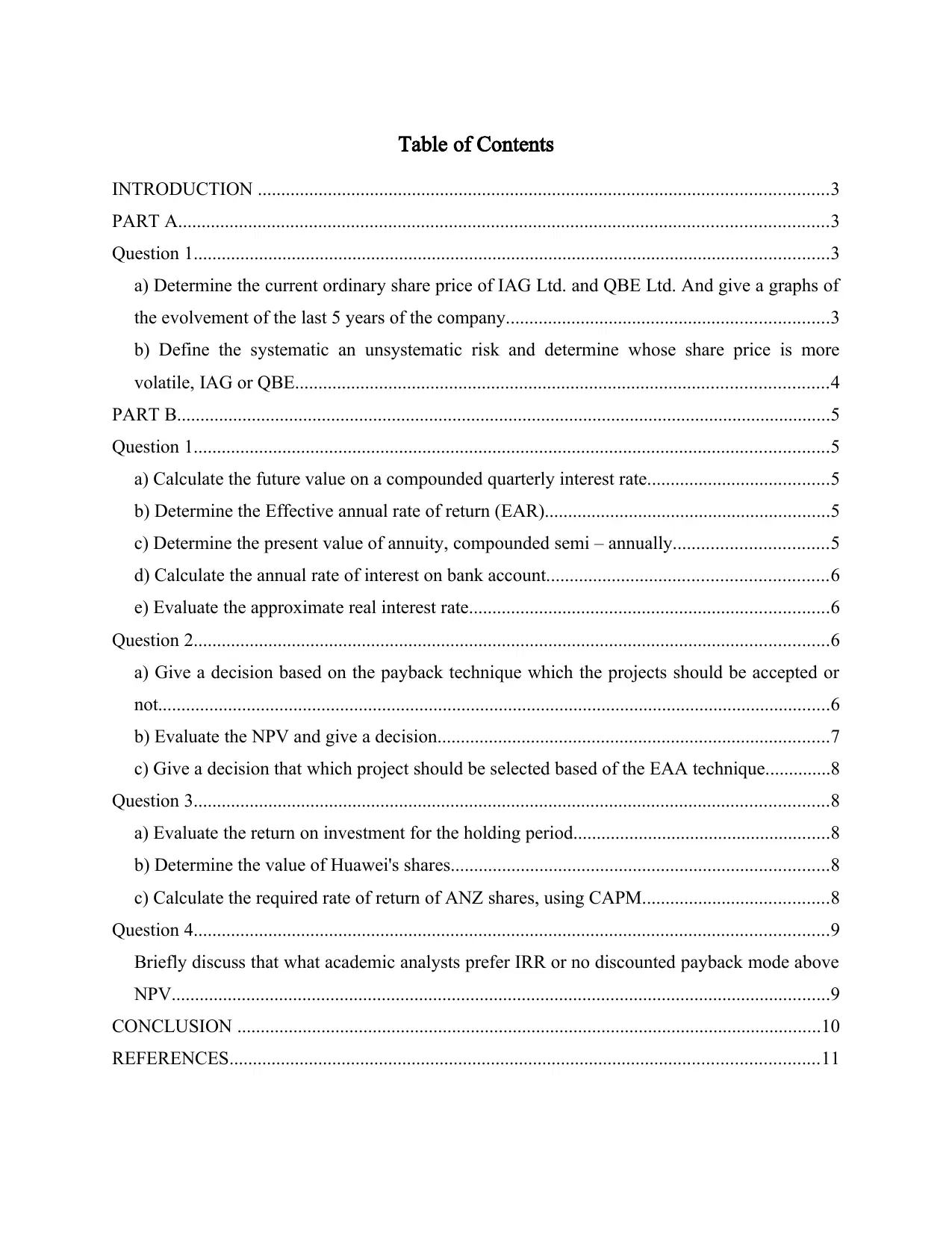
Table of Contents
INTRODUCTION ..........................................................................................................................3
PART A...........................................................................................................................................3
Question 1........................................................................................................................................3
a) Determine the current ordinary share price of IAG Ltd. and QBE Ltd. And give a graphs of
the evolvement of the last 5 years of the company.....................................................................3
b) Define the systematic an unsystematic risk and determine whose share price is more
volatile, IAG or QBE..................................................................................................................4
PART B............................................................................................................................................5
Question 1........................................................................................................................................5
a) Calculate the future value on a compounded quarterly interest rate.......................................5
b) Determine the Effective annual rate of return (EAR).............................................................5
c) Determine the present value of annuity, compounded semi – annually.................................5
d) Calculate the annual rate of interest on bank account............................................................6
e) Evaluate the approximate real interest rate.............................................................................6
Question 2........................................................................................................................................6
a) Give a decision based on the payback technique which the projects should be accepted or
not................................................................................................................................................6
b) Evaluate the NPV and give a decision....................................................................................7
c) Give a decision that which project should be selected based of the EAA technique..............8
Question 3........................................................................................................................................8
a) Evaluate the return on investment for the holding period.......................................................8
b) Determine the value of Huawei's shares.................................................................................8
c) Calculate the required rate of return of ANZ shares, using CAPM........................................8
Question 4........................................................................................................................................9
Briefly discuss that what academic analysts prefer IRR or no discounted payback mode above
NPV.............................................................................................................................................9
CONCLUSION .............................................................................................................................10
REFERENCES..............................................................................................................................11
INTRODUCTION ..........................................................................................................................3
PART A...........................................................................................................................................3
Question 1........................................................................................................................................3
a) Determine the current ordinary share price of IAG Ltd. and QBE Ltd. And give a graphs of
the evolvement of the last 5 years of the company.....................................................................3
b) Define the systematic an unsystematic risk and determine whose share price is more
volatile, IAG or QBE..................................................................................................................4
PART B............................................................................................................................................5
Question 1........................................................................................................................................5
a) Calculate the future value on a compounded quarterly interest rate.......................................5
b) Determine the Effective annual rate of return (EAR).............................................................5
c) Determine the present value of annuity, compounded semi – annually.................................5
d) Calculate the annual rate of interest on bank account............................................................6
e) Evaluate the approximate real interest rate.............................................................................6
Question 2........................................................................................................................................6
a) Give a decision based on the payback technique which the projects should be accepted or
not................................................................................................................................................6
b) Evaluate the NPV and give a decision....................................................................................7
c) Give a decision that which project should be selected based of the EAA technique..............8
Question 3........................................................................................................................................8
a) Evaluate the return on investment for the holding period.......................................................8
b) Determine the value of Huawei's shares.................................................................................8
c) Calculate the required rate of return of ANZ shares, using CAPM........................................8
Question 4........................................................................................................................................9
Briefly discuss that what academic analysts prefer IRR or no discounted payback mode above
NPV.............................................................................................................................................9
CONCLUSION .............................................................................................................................10
REFERENCES..............................................................................................................................11

INTRODUCTION
Corporate finance is an area which deals which the funds, capital budgeting, share prices,
and helps in measuring the volatility of the company (Alter and Elekdag, 2020). In this report,
The current market price of two companies called QBE and IAG is determined by noting the
important points of their evolvement. Then the volatility of both the organisations are evaluated
based on the systematic and unsystematic risks. Further, The different types rate of return and the
future value of the investment were assessed. Moreover, the payback period, NPV and IRR was
calculated and decision will be made based on the present value of both the projects C & D.
Then, the return on investment is calculated based on different methods. Furthermore, the
preference of financial analysts on the basis of NPV, payback and IRR.
PART A
Question 1
a) Determine the current ordinary share price of IAG Ltd. and QBE Ltd. And give a graphs of the
evolvement of the last 5 years of the company.
The Current market price of IAG LTD = $ 4.37
QBE Ltd. = $ 11.60
Corporate finance is an area which deals which the funds, capital budgeting, share prices,
and helps in measuring the volatility of the company (Alter and Elekdag, 2020). In this report,
The current market price of two companies called QBE and IAG is determined by noting the
important points of their evolvement. Then the volatility of both the organisations are evaluated
based on the systematic and unsystematic risks. Further, The different types rate of return and the
future value of the investment were assessed. Moreover, the payback period, NPV and IRR was
calculated and decision will be made based on the present value of both the projects C & D.
Then, the return on investment is calculated based on different methods. Furthermore, the
preference of financial analysts on the basis of NPV, payback and IRR.
PART A
Question 1
a) Determine the current ordinary share price of IAG Ltd. and QBE Ltd. And give a graphs of the
evolvement of the last 5 years of the company.
The Current market price of IAG LTD = $ 4.37
QBE Ltd. = $ 11.60
⊘ This is a preview!⊘
Do you want full access?
Subscribe today to unlock all pages.

Trusted by 1+ million students worldwide

Both the companies have evolved over the years. The QBE Ltd. has a fluctuation performant If
see the market prices of the company. It has not shown a major growth in the last 5 years. In
2020, its market price went high which was around $ 11.600 but then again it slowed down. It is
not showing a constant growth. So, it needs to work on its financial strategy to get more
investors and to increase the monetary health of the organisation.
However, IAG Ltd. has shown a growth in this share price. But, in 2020, it has decreased so
much less. But now it is recovering and is able to increase its market price.
b) Define the systematic an unsystematic risk and determine whose share price is more volatile,
IAG or QBE.
Systematic Risk: This type of risks are non – diversifiable and are inherent to the whole
market.
Unsystematic Risk: This is a risk which is diversifiable or residual. It means it can be reduced
through the diversification.
Drawing : IAG Share price, 2021
Drawin
g 1: Trading Economics, QBE, 2021
see the market prices of the company. It has not shown a major growth in the last 5 years. In
2020, its market price went high which was around $ 11.600 but then again it slowed down. It is
not showing a constant growth. So, it needs to work on its financial strategy to get more
investors and to increase the monetary health of the organisation.
However, IAG Ltd. has shown a growth in this share price. But, in 2020, it has decreased so
much less. But now it is recovering and is able to increase its market price.
b) Define the systematic an unsystematic risk and determine whose share price is more volatile,
IAG or QBE.
Systematic Risk: This type of risks are non – diversifiable and are inherent to the whole
market.
Unsystematic Risk: This is a risk which is diversifiable or residual. It means it can be reduced
through the diversification.
Drawing : IAG Share price, 2021
Drawin
g 1: Trading Economics, QBE, 2021
Paraphrase This Document
Need a fresh take? Get an instant paraphrase of this document with our AI Paraphraser
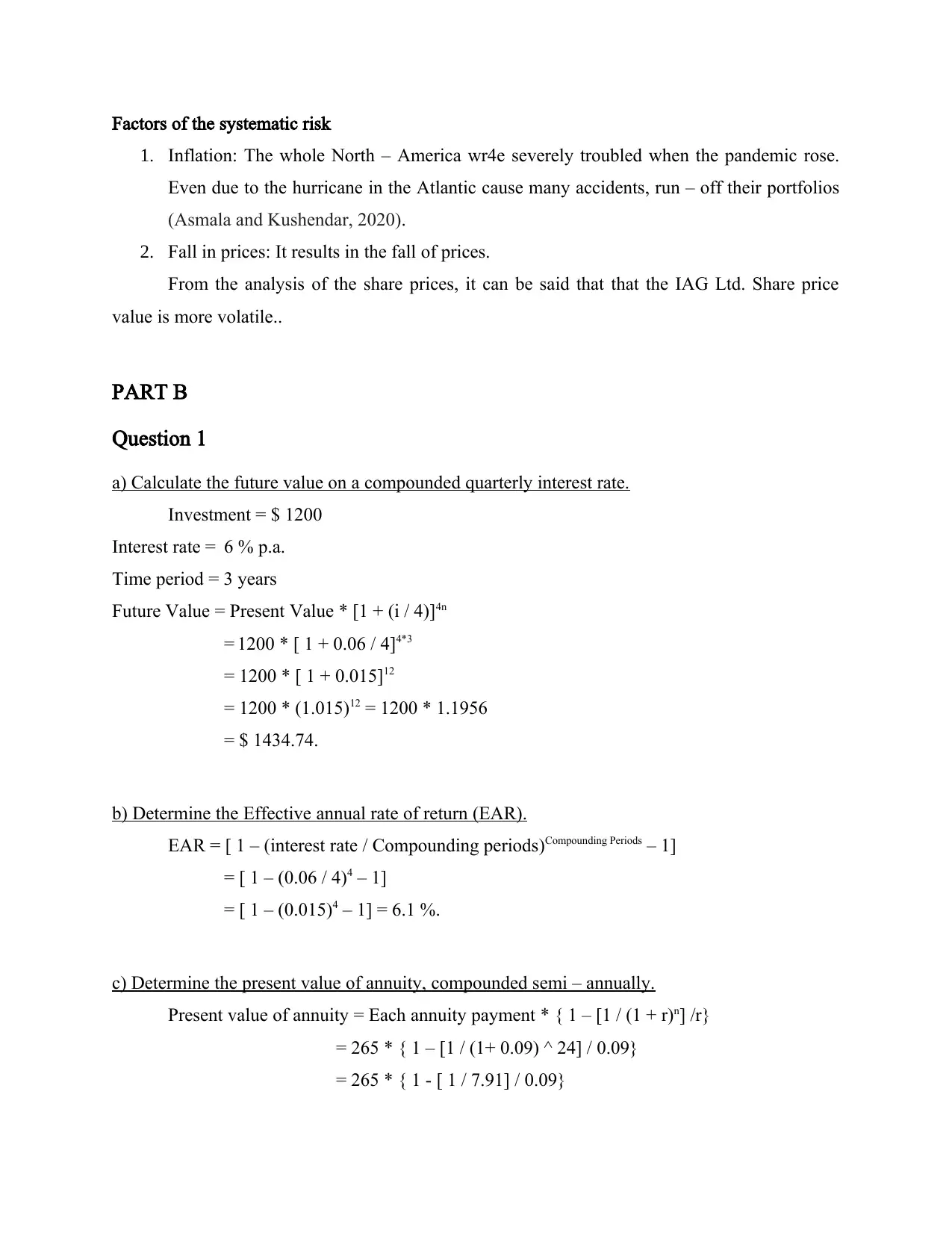
Factors of the systematic risk
1. Inflation: The whole North – America wr4e severely troubled when the pandemic rose.
Even due to the hurricane in the Atlantic cause many accidents, run – off their portfolios
(Asmala and Kushendar, 2020).
2. Fall in prices: It results in the fall of prices.
From the analysis of the share prices, it can be said that that the IAG Ltd. Share price
value is more volatile..
PART B
Question 1
a) Calculate the future value on a compounded quarterly interest rate.
Investment = $ 1200
Interest rate = 6 % p.a.
Time period = 3 years
Future Value = Present Value * [1 + (i / 4)]4n
= 1200 * [ 1 + 0.06 / 4]4*3
= 1200 * [ 1 + 0.015]12
= 1200 * (1.015)12 = 1200 * 1.1956
= $ 1434.74.
b) Determine the Effective annual rate of return (EAR).
EAR = [ 1 – (interest rate / Compounding periods)Compounding Periods – 1]
= [ 1 – (0.06 / 4)4 – 1]
= [ 1 – (0.015)4 – 1] = 6.1 %.
c) Determine the present value of annuity, compounded semi – annually.
Present value of annuity = Each annuity payment * { 1 – [1 / (1 + r)n] /r}
= 265 * { 1 – [1 / (1+ 0.09) ^ 24] / 0.09}
= 265 * { 1 - [ 1 / 7.91] / 0.09}
1. Inflation: The whole North – America wr4e severely troubled when the pandemic rose.
Even due to the hurricane in the Atlantic cause many accidents, run – off their portfolios
(Asmala and Kushendar, 2020).
2. Fall in prices: It results in the fall of prices.
From the analysis of the share prices, it can be said that that the IAG Ltd. Share price
value is more volatile..
PART B
Question 1
a) Calculate the future value on a compounded quarterly interest rate.
Investment = $ 1200
Interest rate = 6 % p.a.
Time period = 3 years
Future Value = Present Value * [1 + (i / 4)]4n
= 1200 * [ 1 + 0.06 / 4]4*3
= 1200 * [ 1 + 0.015]12
= 1200 * (1.015)12 = 1200 * 1.1956
= $ 1434.74.
b) Determine the Effective annual rate of return (EAR).
EAR = [ 1 – (interest rate / Compounding periods)Compounding Periods – 1]
= [ 1 – (0.06 / 4)4 – 1]
= [ 1 – (0.015)4 – 1] = 6.1 %.
c) Determine the present value of annuity, compounded semi – annually.
Present value of annuity = Each annuity payment * { 1 – [1 / (1 + r)n] /r}
= 265 * { 1 – [1 / (1+ 0.09) ^ 24] / 0.09}
= 265 * { 1 - [ 1 / 7.91] / 0.09}
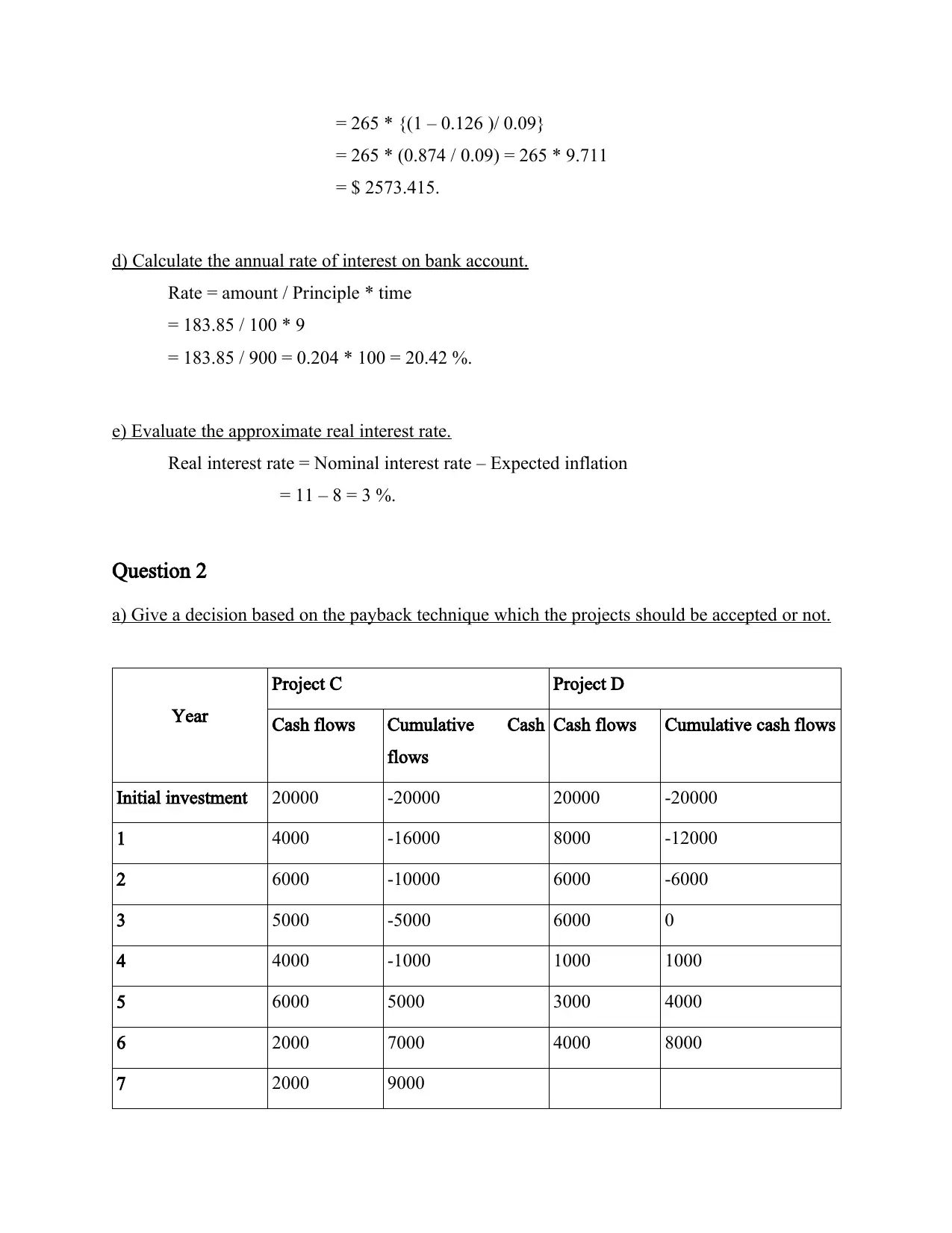
= 265 * {(1 – 0.126 )/ 0.09}
= 265 * (0.874 / 0.09) = 265 * 9.711
= $ 2573.415.
d) Calculate the annual rate of interest on bank account.
Rate = amount / Principle * time
= 183.85 / 100 * 9
= 183.85 / 900 = 0.204 * 100 = 20.42 %.
e) Evaluate the approximate real interest rate.
Real interest rate = Nominal interest rate – Expected inflation
= 11 – 8 = 3 %.
Question 2
a) Give a decision based on the payback technique which the projects should be accepted or not.
Year
Project C Project D
Cash flows Cumulative Cash
flows
Cash flows Cumulative cash flows
Initial investment 20000 -20000 20000 -20000
1 4000 -16000 8000 -12000
2 6000 -10000 6000 -6000
3 5000 -5000 6000 0
4 4000 -1000 1000 1000
5 6000 5000 3000 4000
6 2000 7000 4000 8000
7 2000 9000
= 265 * (0.874 / 0.09) = 265 * 9.711
= $ 2573.415.
d) Calculate the annual rate of interest on bank account.
Rate = amount / Principle * time
= 183.85 / 100 * 9
= 183.85 / 900 = 0.204 * 100 = 20.42 %.
e) Evaluate the approximate real interest rate.
Real interest rate = Nominal interest rate – Expected inflation
= 11 – 8 = 3 %.
Question 2
a) Give a decision based on the payback technique which the projects should be accepted or not.
Year
Project C Project D
Cash flows Cumulative Cash
flows
Cash flows Cumulative cash flows
Initial investment 20000 -20000 20000 -20000
1 4000 -16000 8000 -12000
2 6000 -10000 6000 -6000
3 5000 -5000 6000 0
4 4000 -1000 1000 1000
5 6000 5000 3000 4000
6 2000 7000 4000 8000
7 2000 9000
⊘ This is a preview!⊘
Do you want full access?
Subscribe today to unlock all pages.

Trusted by 1+ million students worldwide
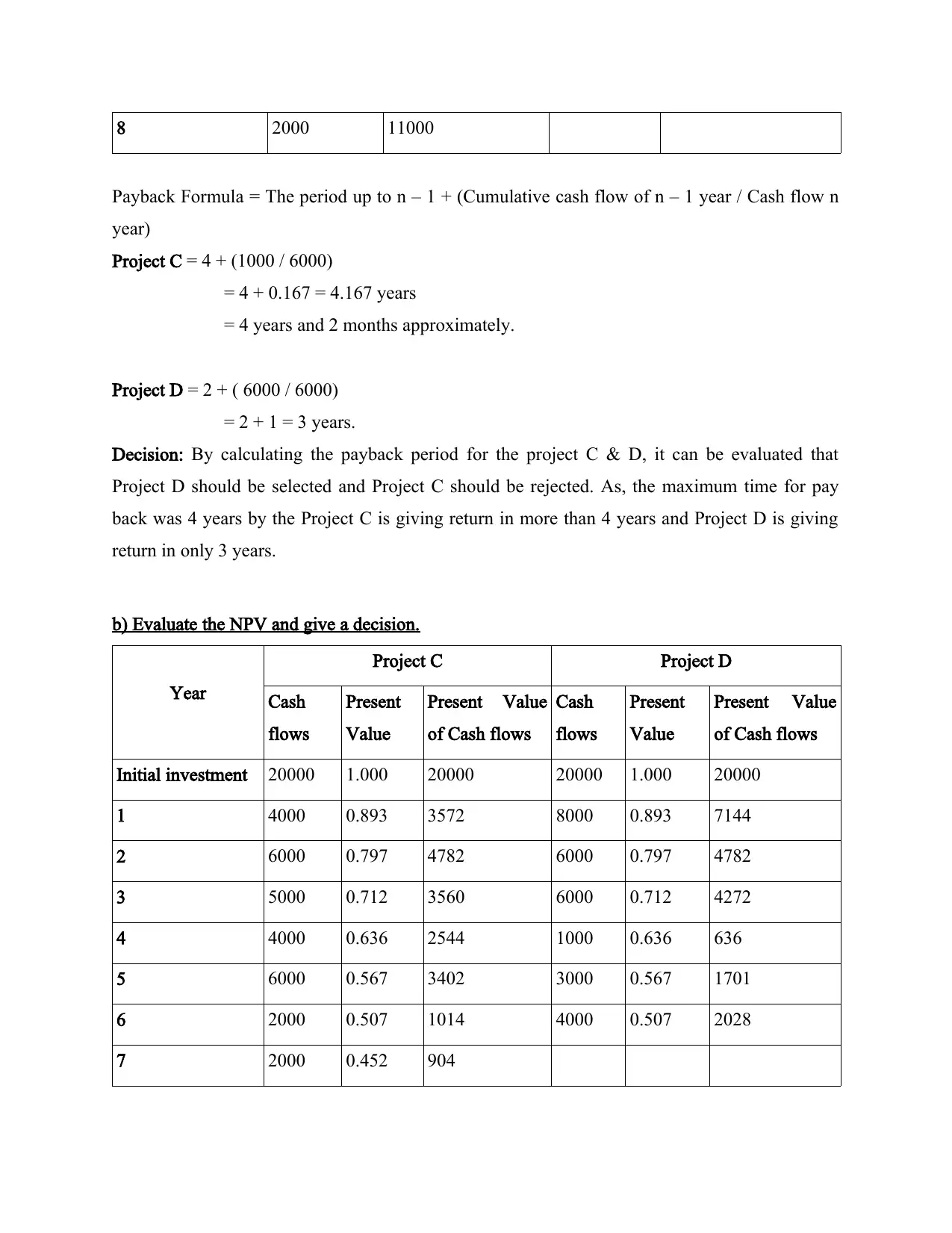
8 2000 11000
Payback Formula = The period up to n – 1 + (Cumulative cash flow of n – 1 year / Cash flow n
year)
Project C = 4 + (1000 / 6000)
= 4 + 0.167 = 4.167 years
= 4 years and 2 months approximately.
Project D = 2 + ( 6000 / 6000)
= 2 + 1 = 3 years.
Decision: By calculating the payback period for the project C & D, it can be evaluated that
Project D should be selected and Project C should be rejected. As, the maximum time for pay
back was 4 years by the Project C is giving return in more than 4 years and Project D is giving
return in only 3 years.
b) Evaluate the NPV and give a decision.
Year
Project C Project D
Cash
flows
Present
Value
Present Value
of Cash flows
Cash
flows
Present
Value
Present Value
of Cash flows
Initial investment 20000 1.000 20000 20000 1.000 20000
1 4000 0.893 3572 8000 0.893 7144
2 6000 0.797 4782 6000 0.797 4782
3 5000 0.712 3560 6000 0.712 4272
4 4000 0.636 2544 1000 0.636 636
5 6000 0.567 3402 3000 0.567 1701
6 2000 0.507 1014 4000 0.507 2028
7 2000 0.452 904
Payback Formula = The period up to n – 1 + (Cumulative cash flow of n – 1 year / Cash flow n
year)
Project C = 4 + (1000 / 6000)
= 4 + 0.167 = 4.167 years
= 4 years and 2 months approximately.
Project D = 2 + ( 6000 / 6000)
= 2 + 1 = 3 years.
Decision: By calculating the payback period for the project C & D, it can be evaluated that
Project D should be selected and Project C should be rejected. As, the maximum time for pay
back was 4 years by the Project C is giving return in more than 4 years and Project D is giving
return in only 3 years.
b) Evaluate the NPV and give a decision.
Year
Project C Project D
Cash
flows
Present
Value
Present Value
of Cash flows
Cash
flows
Present
Value
Present Value
of Cash flows
Initial investment 20000 1.000 20000 20000 1.000 20000
1 4000 0.893 3572 8000 0.893 7144
2 6000 0.797 4782 6000 0.797 4782
3 5000 0.712 3560 6000 0.712 4272
4 4000 0.636 2544 1000 0.636 636
5 6000 0.567 3402 3000 0.567 1701
6 2000 0.507 1014 4000 0.507 2028
7 2000 0.452 904
Paraphrase This Document
Need a fresh take? Get an instant paraphrase of this document with our AI Paraphraser
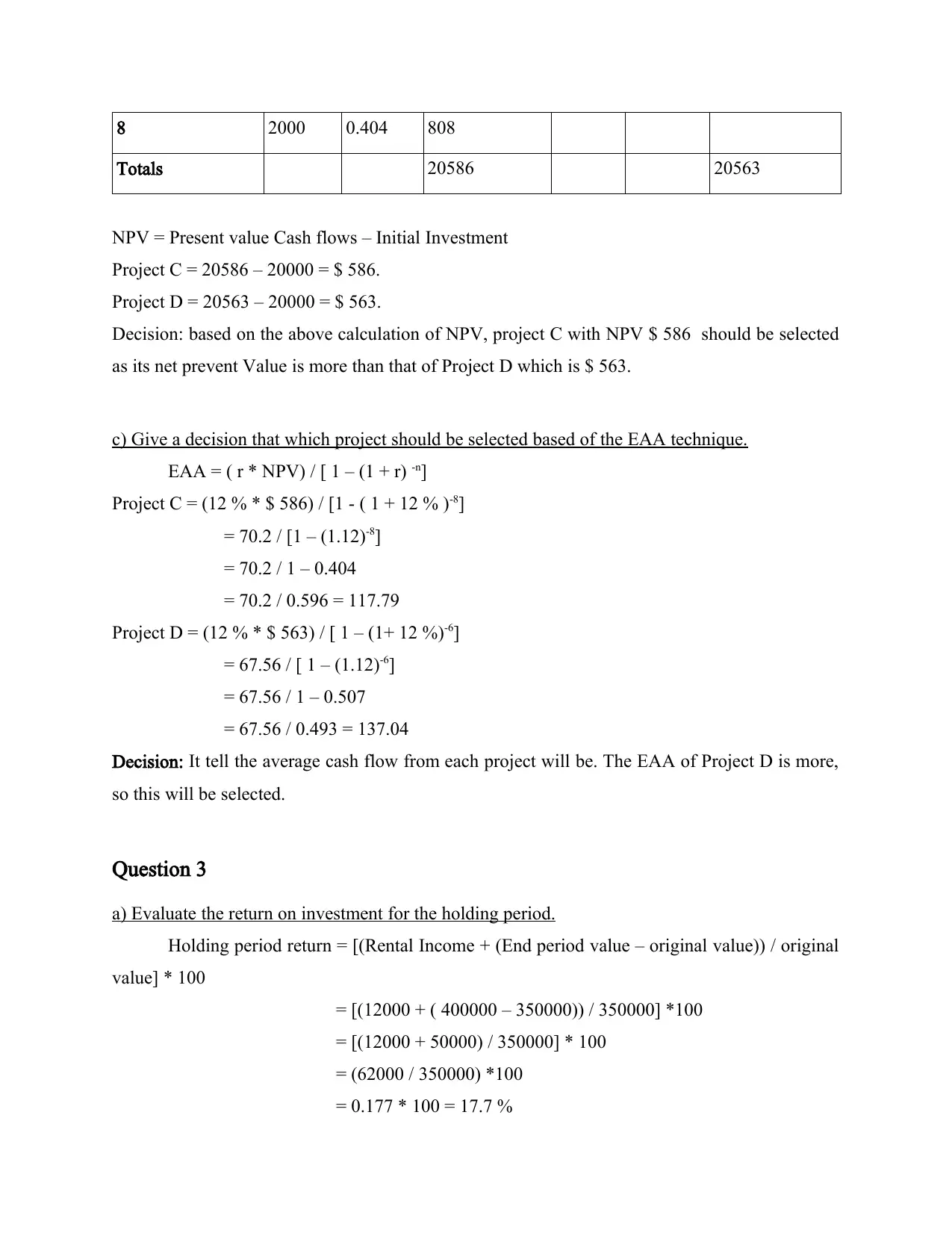
8 2000 0.404 808
Totals 20586 20563
NPV = Present value Cash flows – Initial Investment
Project C = 20586 – 20000 = $ 586.
Project D = 20563 – 20000 = $ 563.
Decision: based on the above calculation of NPV, project C with NPV $ 586 should be selected
as its net prevent Value is more than that of Project D which is $ 563.
c) Give a decision that which project should be selected based of the EAA technique.
EAA = ( r * NPV) / [ 1 – (1 + r) -n]
Project C = (12 % * $ 586) / [1 - ( 1 + 12 % )-8]
= 70.2 / [1 – (1.12)-8]
= 70.2 / 1 – 0.404
= 70.2 / 0.596 = 117.79
Project D = (12 % * $ 563) / [ 1 – (1+ 12 %)-6]
= 67.56 / [ 1 – (1.12)-6]
= 67.56 / 1 – 0.507
= 67.56 / 0.493 = 137.04
Decision: It tell the average cash flow from each project will be. The EAA of Project D is more,
so this will be selected.
Question 3
a) Evaluate the return on investment for the holding period.
Holding period return = [(Rental Income + (End period value – original value)) / original
value] * 100
= [(12000 + ( 400000 – 350000)) / 350000] *100
= [(12000 + 50000) / 350000] * 100
= (62000 / 350000) *100
= 0.177 * 100 = 17.7 %
Totals 20586 20563
NPV = Present value Cash flows – Initial Investment
Project C = 20586 – 20000 = $ 586.
Project D = 20563 – 20000 = $ 563.
Decision: based on the above calculation of NPV, project C with NPV $ 586 should be selected
as its net prevent Value is more than that of Project D which is $ 563.
c) Give a decision that which project should be selected based of the EAA technique.
EAA = ( r * NPV) / [ 1 – (1 + r) -n]
Project C = (12 % * $ 586) / [1 - ( 1 + 12 % )-8]
= 70.2 / [1 – (1.12)-8]
= 70.2 / 1 – 0.404
= 70.2 / 0.596 = 117.79
Project D = (12 % * $ 563) / [ 1 – (1+ 12 %)-6]
= 67.56 / [ 1 – (1.12)-6]
= 67.56 / 1 – 0.507
= 67.56 / 0.493 = 137.04
Decision: It tell the average cash flow from each project will be. The EAA of Project D is more,
so this will be selected.
Question 3
a) Evaluate the return on investment for the holding period.
Holding period return = [(Rental Income + (End period value – original value)) / original
value] * 100
= [(12000 + ( 400000 – 350000)) / 350000] *100
= [(12000 + 50000) / 350000] * 100
= (62000 / 350000) *100
= 0.177 * 100 = 17.7 %

The Yin Zhang's holding period rerun on investment is 17.7 %.
b) Determine the value of Huawei's shares.
Stock Value = Dividend per share / ( Required rate of return – dividend growth rate)
= 0.90 / (15 % - 10 %)
= 0.90 / 5% = $ 18.
c) Calculate the required rate of return of ANZ shares, using CAPM.
Rf = 3 %
Beta = 1.2
RM = 12 %
RRR = Risk free rate of return + Beta * ( Market rate – risk free rate)
= 0.03 + 1.2 * (1.2 – 0.03)
= 0.03 + 1.2 * 1.17
= 0.03 + 1.404 = 1.434%
The required rate of return for ANZ share should be 1.434 %.
Question 4
Briefly discuss that what academic analysts prefer IRR or no discounted payback mode above
NPV.
Capital budgeting helps the investors in determining the value of the investment. The
most common techniques of the selecting the project is Payback period, NPV and IRR.
Basis IRR NPV Payback period
Definition The rate at which the
current worth of future
cash flows are equal to
the cash outflows.
It is a technique that is
utilized to decide the
current worth of all
future cash flows
which will be
produced by the
The time at which the
amount is recovered of
the initial investment.
b) Determine the value of Huawei's shares.
Stock Value = Dividend per share / ( Required rate of return – dividend growth rate)
= 0.90 / (15 % - 10 %)
= 0.90 / 5% = $ 18.
c) Calculate the required rate of return of ANZ shares, using CAPM.
Rf = 3 %
Beta = 1.2
RM = 12 %
RRR = Risk free rate of return + Beta * ( Market rate – risk free rate)
= 0.03 + 1.2 * (1.2 – 0.03)
= 0.03 + 1.2 * 1.17
= 0.03 + 1.404 = 1.434%
The required rate of return for ANZ share should be 1.434 %.
Question 4
Briefly discuss that what academic analysts prefer IRR or no discounted payback mode above
NPV.
Capital budgeting helps the investors in determining the value of the investment. The
most common techniques of the selecting the project is Payback period, NPV and IRR.
Basis IRR NPV Payback period
Definition The rate at which the
current worth of future
cash flows are equal to
the cash outflows.
It is a technique that is
utilized to decide the
current worth of all
future cash flows
which will be
produced by the
The time at which the
amount is recovered of
the initial investment.
⊘ This is a preview!⊘
Do you want full access?
Subscribe today to unlock all pages.

Trusted by 1+ million students worldwide
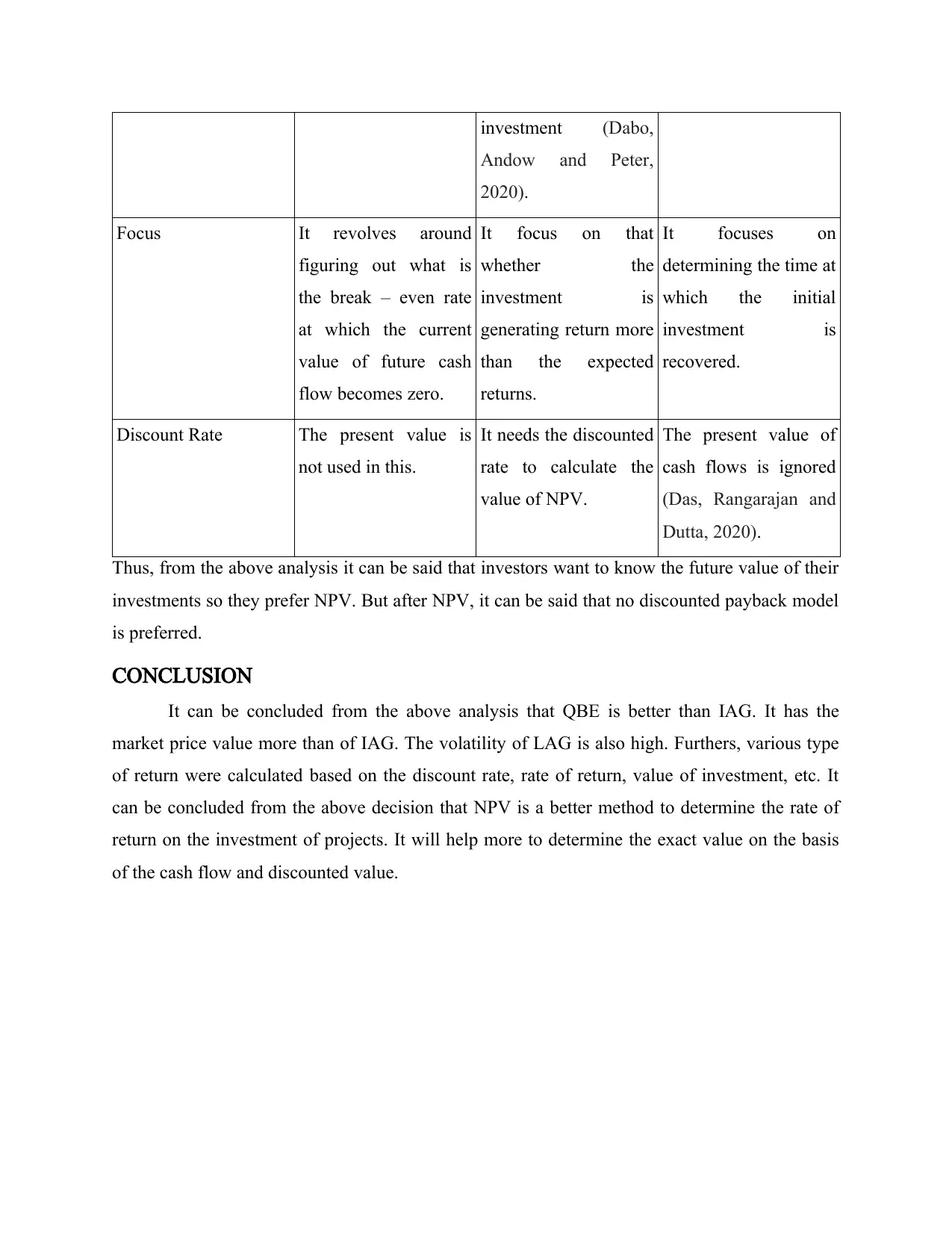
investment (Dabo,
Andow and Peter,
2020).
Focus It revolves around
figuring out what is
the break – even rate
at which the current
value of future cash
flow becomes zero.
It focus on that
whether the
investment is
generating return more
than the expected
returns.
It focuses on
determining the time at
which the initial
investment is
recovered.
Discount Rate The present value is
not used in this.
It needs the discounted
rate to calculate the
value of NPV.
The present value of
cash flows is ignored
(Das, Rangarajan and
Dutta, 2020).
Thus, from the above analysis it can be said that investors want to know the future value of their
investments so they prefer NPV. But after NPV, it can be said that no discounted payback model
is preferred.
CONCLUSION
It can be concluded from the above analysis that QBE is better than IAG. It has the
market price value more than of IAG. The volatility of LAG is also high. Furthers, various type
of return were calculated based on the discount rate, rate of return, value of investment, etc. It
can be concluded from the above decision that NPV is a better method to determine the rate of
return on the investment of projects. It will help more to determine the exact value on the basis
of the cash flow and discounted value.
Andow and Peter,
2020).
Focus It revolves around
figuring out what is
the break – even rate
at which the current
value of future cash
flow becomes zero.
It focus on that
whether the
investment is
generating return more
than the expected
returns.
It focuses on
determining the time at
which the initial
investment is
recovered.
Discount Rate The present value is
not used in this.
It needs the discounted
rate to calculate the
value of NPV.
The present value of
cash flows is ignored
(Das, Rangarajan and
Dutta, 2020).
Thus, from the above analysis it can be said that investors want to know the future value of their
investments so they prefer NPV. But after NPV, it can be said that no discounted payback model
is preferred.
CONCLUSION
It can be concluded from the above analysis that QBE is better than IAG. It has the
market price value more than of IAG. The volatility of LAG is also high. Furthers, various type
of return were calculated based on the discount rate, rate of return, value of investment, etc. It
can be concluded from the above decision that NPV is a better method to determine the rate of
return on the investment of projects. It will help more to determine the exact value on the basis
of the cash flow and discounted value.
Paraphrase This Document
Need a fresh take? Get an instant paraphrase of this document with our AI Paraphraser
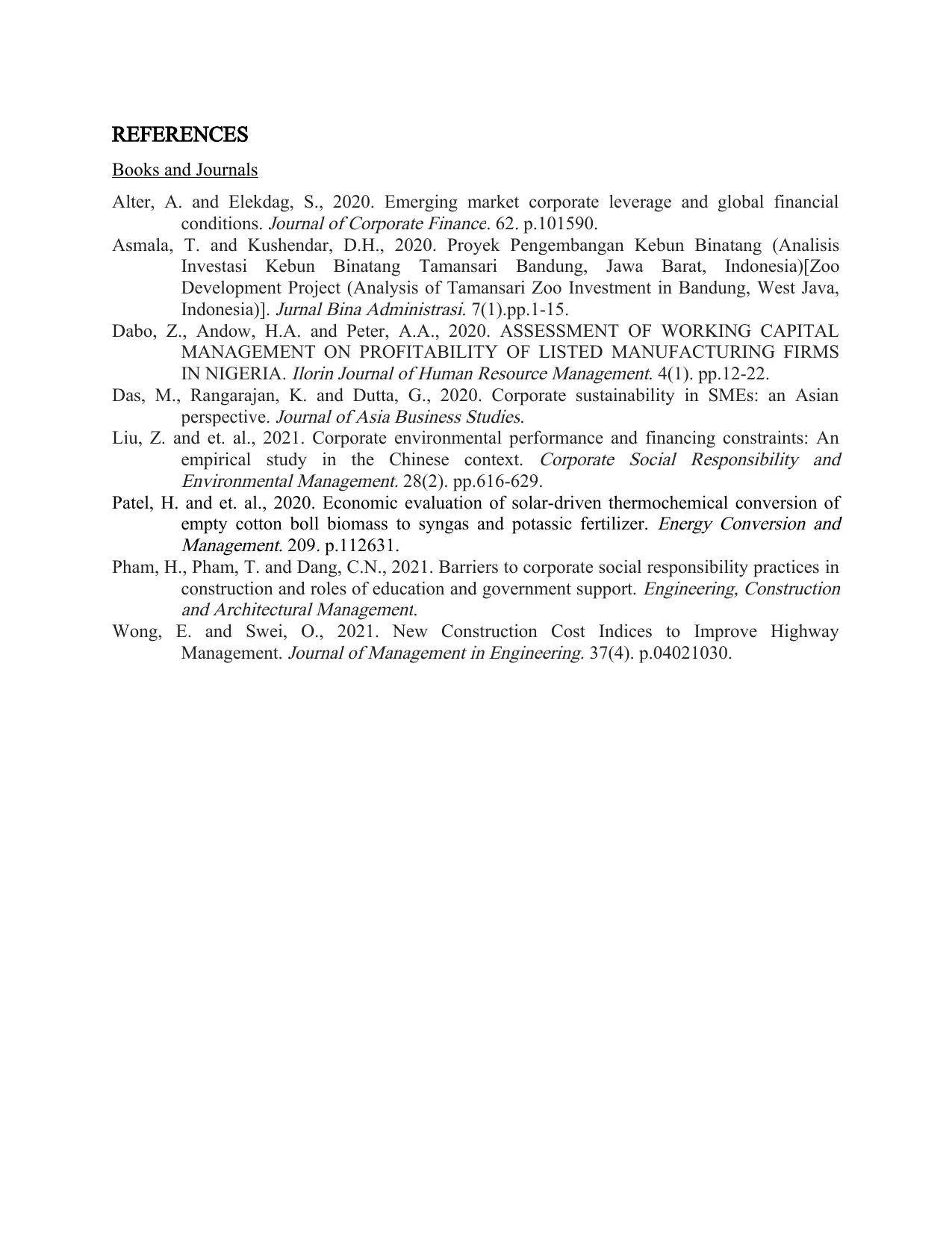
REFERENCES
Books and Journals
Alter, A. and Elekdag, S., 2020. Emerging market corporate leverage and global financial
conditions.
Journal of Corporate Finance. 62. p.101590.
Asmala, T. and Kushendar, D.H., 2020. Proyek Pengembangan Kebun Binatang (Analisis
Investasi Kebun Binatang Tamansari Bandung, Jawa Barat, Indonesia)[Zoo
Development Project (Analysis of Tamansari Zoo Investment in Bandung, West Java,
Indonesia)].
Jurnal Bina Administrasi. 7(1).pp.1-15.
Dabo, Z., Andow, H.A. and Peter, A.A., 2020. ASSESSMENT OF WORKING CAPITAL
MANAGEMENT ON PROFITABILITY OF LISTED MANUFACTURING FIRMS
IN NIGERIA.
Ilorin Journal of Human Resource Management. 4(1). pp.12-22.
Das, M., Rangarajan, K. and Dutta, G., 2020. Corporate sustainability in SMEs: an Asian
perspective.
Journal of Asia Business Studies.
Liu, Z. and et. al., 2021. Corporate environmental performance and financing constraints: An
empirical study in the Chinese context.
Corporate Social Responsibility and
Environmental Management. 28(2). pp.616-629.
Patel, H. and et. al., 2020. Economic evaluation of solar-driven thermochemical conversion of
empty cotton boll biomass to syngas and potassic fertilizer.
Energy Conversion and
Management. 209. p.112631.
Pham, H., Pham, T. and Dang, C.N., 2021. Barriers to corporate social responsibility practices in
construction and roles of education and government support.
Engineering, Construction
and Architectural Management.
Wong, E. and Swei, O., 2021. New Construction Cost Indices to Improve Highway
Management.
Journal of Management in Engineering. 37(4). p.04021030.
Books and Journals
Alter, A. and Elekdag, S., 2020. Emerging market corporate leverage and global financial
conditions.
Journal of Corporate Finance. 62. p.101590.
Asmala, T. and Kushendar, D.H., 2020. Proyek Pengembangan Kebun Binatang (Analisis
Investasi Kebun Binatang Tamansari Bandung, Jawa Barat, Indonesia)[Zoo
Development Project (Analysis of Tamansari Zoo Investment in Bandung, West Java,
Indonesia)].
Jurnal Bina Administrasi. 7(1).pp.1-15.
Dabo, Z., Andow, H.A. and Peter, A.A., 2020. ASSESSMENT OF WORKING CAPITAL
MANAGEMENT ON PROFITABILITY OF LISTED MANUFACTURING FIRMS
IN NIGERIA.
Ilorin Journal of Human Resource Management. 4(1). pp.12-22.
Das, M., Rangarajan, K. and Dutta, G., 2020. Corporate sustainability in SMEs: an Asian
perspective.
Journal of Asia Business Studies.
Liu, Z. and et. al., 2021. Corporate environmental performance and financing constraints: An
empirical study in the Chinese context.
Corporate Social Responsibility and
Environmental Management. 28(2). pp.616-629.
Patel, H. and et. al., 2020. Economic evaluation of solar-driven thermochemical conversion of
empty cotton boll biomass to syngas and potassic fertilizer.
Energy Conversion and
Management. 209. p.112631.
Pham, H., Pham, T. and Dang, C.N., 2021. Barriers to corporate social responsibility practices in
construction and roles of education and government support.
Engineering, Construction
and Architectural Management.
Wong, E. and Swei, O., 2021. New Construction Cost Indices to Improve Highway
Management.
Journal of Management in Engineering. 37(4). p.04021030.
1 out of 11
Related Documents
Your All-in-One AI-Powered Toolkit for Academic Success.
+13062052269
info@desklib.com
Available 24*7 on WhatsApp / Email
![[object Object]](/_next/static/media/star-bottom.7253800d.svg)
Unlock your academic potential
Copyright © 2020–2025 A2Z Services. All Rights Reserved. Developed and managed by ZUCOL.





